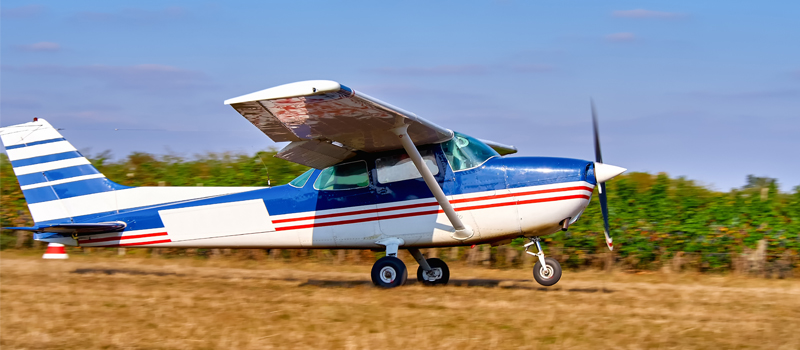-
Key Takeaways
-
What Is a Cadet Pilot Program?
- The 5 Basic Steps of a Cadet Program
- Cadet Program Requirements
- Training Duration and Phases
- Airline Affiliation
-
Pros of Joining a Cadet Pilot Program
- 1. Clear Career Path
- 2. Structured Training
- 3. Financial Benefits
- 4. Mentorship
- 5. Networking
-
Cons of Cadet Pilot Programs
- 1. Financial Risk
- 2. Tied Into a Contract
- 3. Performance Pressure
- 4. Geographic Restrictions
- 5. Job Market Fluctuations
-
Factors to Consider When Choosing a Cadet Program
- 1. Financial Terms
- 2. Program Quality
- 3. Airline Reputation
- 4. Contract Details
- 5. Success Metrics
-
Is a Cadet Pilot Program Worth It?
- The Chances of Success Are Higher if You:
- Consider Alternative Paths if You:
-
Conclusion
For student pilots and private pilots, a cadet pilot program might seem like the ideal route. These programs offer an immersive, structured training path that is often in partnership with the airlines.
Cadet programs are tailored to get you from a novice to a licensed pilot with a direct path to employment after graduation.
They may seem tempting with their financial perks—but that’s not the full picture.
There are obligations and financial risks involved, and the structured path isn’t for everyone.
In this article, we’ll get into the advantages and disadvantages to help you decide if it’s the right choice for you.
Key Takeaways
- Cadet pilot programs offer a path to becoming an airline pilot with guaranteed employment.
- These programs require a significant financial investment but often provide better loan terms than traditional training.
- Training quality varies between programs, with major airlines offering better resources.
- Success depends heavily on maintaining high academic performance and an aptitude for flying.
What Is a Cadet Pilot Program?
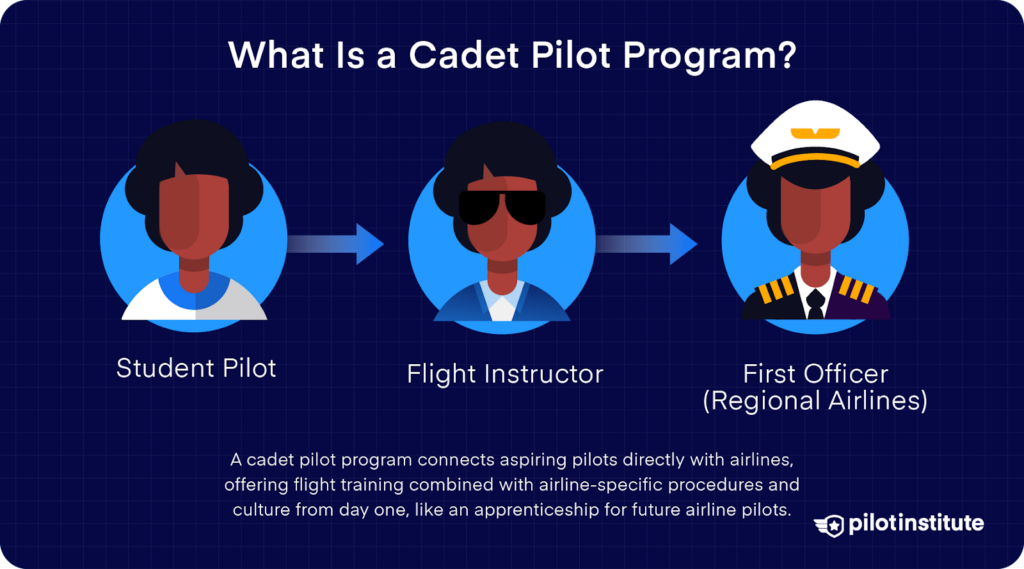
A cadet pilot program provides a direct link between aspiring pilots and airlines. Think of it as an apprenticeship program for future airline pilots. These programs combine flight training with airline-specific procedures and culture from day one.
The training structure usually consists of three main phases:
- Education: Ground school, which focuses on aviation theory and Federal Aviation Administration (FAA) knowledge requirements.
- Training: Flight training to build hands-on skills in various aircraft types.
- Airline Orientation: This phase prepares you for airline company procedures.
The 5 Basic Steps of a Cadet Program
- Obtain flight certificates.
- Build hours as a flight instructor.
- Transition to a regional airline.
- Gain more experience.
- Join a major airline.
Cadet Program Requirements
Most cadet pilot programs require you to be at least 18 years old and have a high school diploma. Since English is the universal language of aviation, you’ll need to be comfortable with it both in the classroom and on the radio.
Before starting a cadet program, you must pass a series of physical and mental tests. This involves obtaining a First-Class Medical Certificate from an FAA-designated Aviation Medical Examiner. This lets the airlines know you’re physically ready for the cockpit.
And here’s a big one: If you plan to go the cadet program route, you have to agree to a full-time commitment. As a new cadet, you will have to attend classes, study, and learn how to fly in an intensive 40-hour per-week training program.
Note: To apply, you do not require any previous flight experience and may hold no more than a Private Pilot license when applying or beginning most cadet programs.
Training Duration and Phases
The training duration from obtaining a Private Pilot License to becoming a Certified Flight Instructor – Instrument (CFII) is around 12 to 18 months. However, this timeline may vary based on individual progress and external factors, such as weather conditions and aircraft availability.
After earning your flight certifications, you’ll work as a paid Flight Instructor for two-and-a-half years or less to gain more flight hours. After you reach 750 or 1,500 flight hours (depending on the program), you become eligible for an interview with a regional airline partner.
Airline Affiliation
Unlike traditional flight training, cadet pilot programs require a multi-year commitment. Upon completion, you sign an agreement to work for the sponsoring airline, which is different from regular flight training, where you can choose an employer freely.
For example, Southwest Airlines has partnered with three cadet pilot training schools: CAE, SkyWarrior, and US Aviation. After finishing your initial training and a four-year contract with a partner airline, you can transition into a First Officer role at Southwest.
Pros of Joining a Cadet Pilot Program
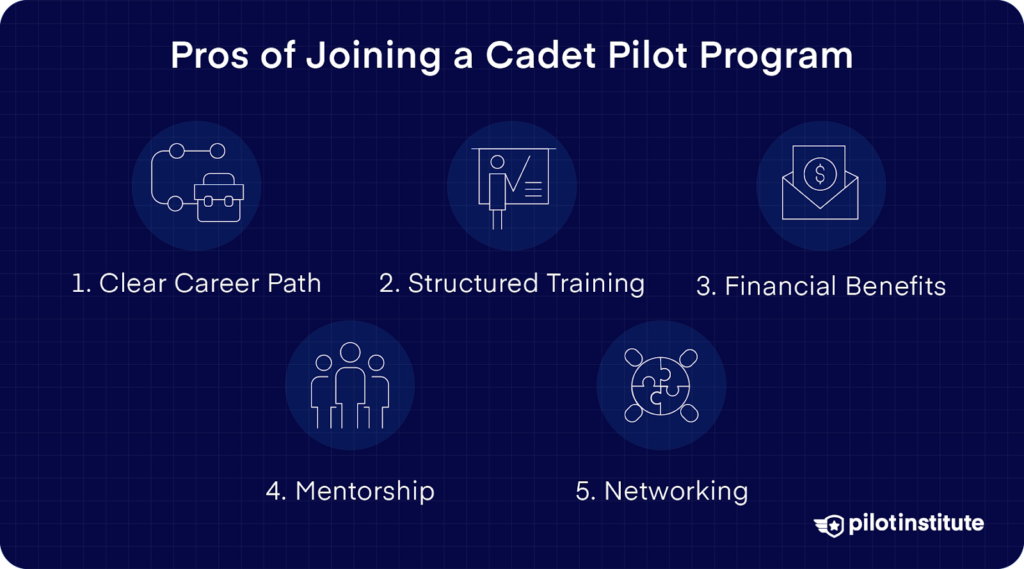
Cadet pilot programs have become the first choice for many potential candidates. If you dream of having an airline career, these programs offer many advantages. Think of it as getting a fast pass to the airline industry – there’s a lot to like about these structured programs.
1. Clear Career Path
Cadet programs remove the guesswork from securing a job with an airline. After training, you will know exactly where you’ll work, which brings a sense of security during the demanding process of becoming a pilot.
2. Structured Training
Airlines don’t leave anything to chance when it comes to training their future pilots. Cadet programs organize your training in a clear sequence with regular assessments. This methodical approach develops the right habits from the beginning.
3. Financial Benefits
Training to become a pilot is expensive. The good news? Airlines frequently collaborate with banks to offer favorable loans, and some even cover part of your training expenses.
4. Mentorship
Want to know what it’s really like in the airline world? Mentors will show you the ropes. These experienced pilots have been where you’re going, and they’re eager to share their wisdom. They’ll teach you things you won’t find in any textbook.
5. Networking
Remember that saying it’s not just what you know, but who you know? As a cadet, you will train alongside some of your future coworkers. These relationships can enhance career advancement throughout your aviation journey.
Cons of Cadet Pilot Programs
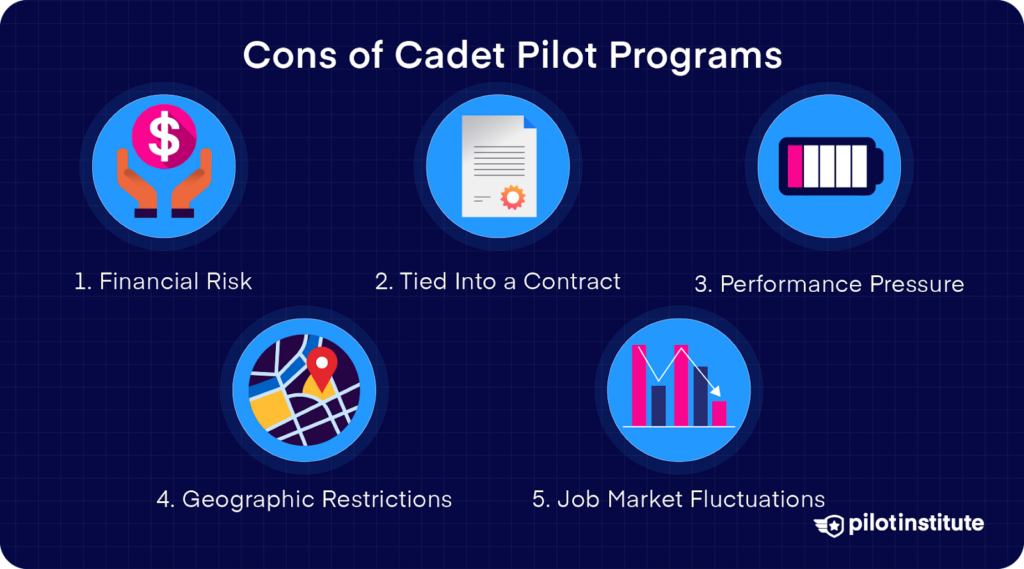
Before joining a cadet pilot program, you must look at all aspects of training. Like any major career decision, these programs have some drawbacks. So, let’s dive into some challenges you might face if you choose this path.
1. Financial Risk
Most cadet programs can easily set you back $100,000 (the average cost is $80,000 to $150,000). Here’s the tricky part: if you have trouble passing checkrides or face medical issues, you could find yourself grounded before your career takes off. This situation can leave you with a substantial debt.
2. Tied Into a Contract
Once you sign a contract, you’re usually locked in for several years. This makes it difficult to switch carriers if better opportunities come up. Some pilots find this lack of freedom frustrating as they advance in their careers.
3. Performance Pressure
Cadet programs are more demanding, with high academic and performance standards. You have to learn and train full-time for 40 hours every week. One failed checkride doesn’t just mean a bad day; it could throw your whole training timeline off track.
4. Geographic Restrictions
Before joining a cadet program, you should inquire about the training locations. It can require moving across the country, far from family and friends. Depending on the airline, some programs even require international travel for certain training phases.
5. Job Market Fluctuations
The airline industry can sometimes be as unpredictable as the weather. Economic fluctuations might delay hiring processes or change contract conditions. This uncertainty can add to the stress of an already demanding journey.
Factors to Consider When Choosing a Cadet Program
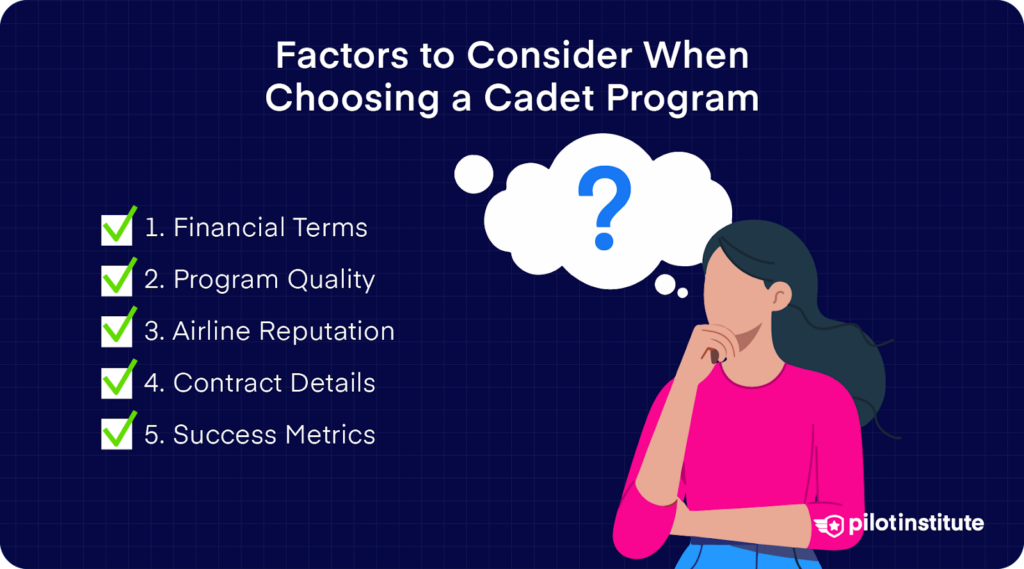
If you’re seriously considering joining a cadet pilot program—that’s exciting! But hold on because choosing the right program requires careful consideration. Here’s what you should look for when evaluating different cadet programs.
1. Financial Terms
Do you know the sticker price cadet programs advertise? That’s just the beginning. You should ask if there are any hidden fees or contract-specific terms. And don’t forget about living expenses because you still need to eat and sleep somewhere during training.
2. Program Quality
Not all cadet programs are created equal. Think of this like checking out a potential college. First, take a good look at their classroom and training aircraft. Are they modern, well-maintained, or outdated? You’ll want to know who’s teaching you too.
3. Airline Reputation
Remember, you’re not just joining a program – you’re potentially committing to an airline for years. How stable is the company? Are they growing or struggling? Take a look at their fleet plans. Are they still flying aircraft from the 80s or investing in modern jets?
4. Contract Details
Before joining, review the terms of the training contract. And where you might end up living? While the airline may have big city bases, you might end up working from a smaller city you’ve never heard of. It’s better to know this from the start.
5. Success Metrics
Lastly, review the airline’s success record. How long does it take cadets to complete the program? Try to connect with former students. Their feedback can tell you about the program’s pros and cons, which may not be apparent in their promotional materials.
Is a Cadet Pilot Program Worth It?
Here’s a question that every aspiring pilot eventually asks themselves: Is the cadet pilot program worth it? The answer isn’t simple because it depends on your situation and goals. Let’s break down who tends to succeed in these programs and who might want to consider other options.
The Chances of Success Are Higher if You:
- Enjoy structured learning environments.
- Possess strong academic skills.
- Can manage high-pressure situations.
- Desire a clear career trajectory.
- Have access to funding for the program.
Consider Alternative Paths if You:
- Require flexibility in your training schedule.
- Want the freedom to choose your employer.
- Prefer to learn independently.
- Have limited financial means.
- Need to keep your current job.
Conclusion
Cadet pilot programs are a fast-track route to becoming an airline pilot, but they come with commitments that aren’t easy to ignore.
The built-in job prospects, mentorship, and curriculum are definite advantages. This is especially true if you want a clear career path with an airline right after training.
But you’ll be signing up for a contract and possibly a significant debt that can feel restrictive later.
Deciding whether a cadet program is worth it boils down to your priorities. Do you value immediate job security, or would you rather explore broader options?
Take your time, do the research, and remember—it’s your career path, so make sure it’s a choice that fits your goals and lifestyle.

